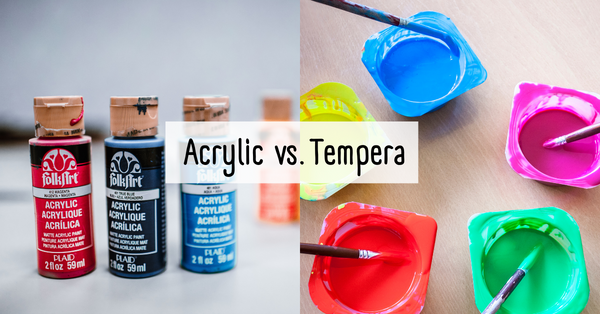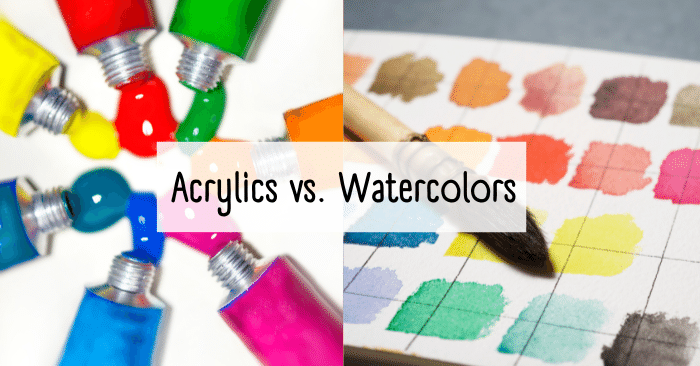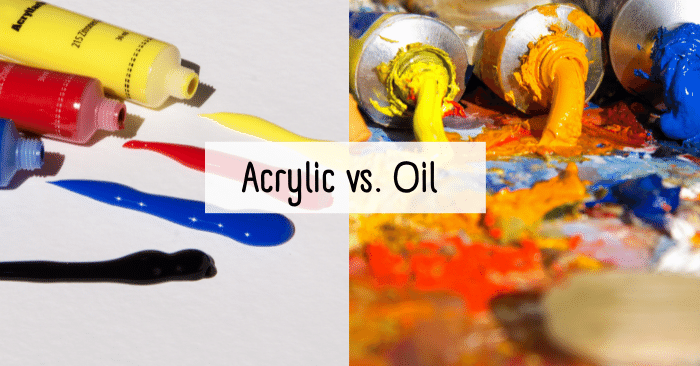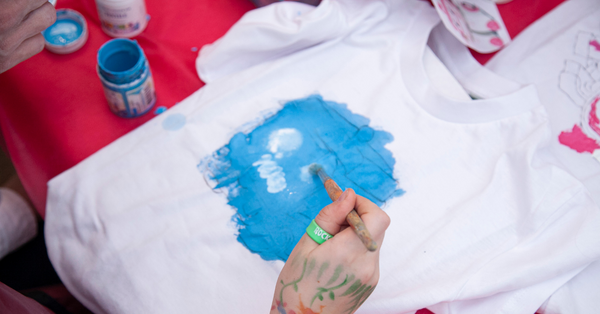
You’ve almost definitely heard about acrylic paint – it’s one of the most common and versatile paints on the market. However, you might not be too familiar with tempera, unless you remember using it for finger painting in the second grade. It’s known for being non-toxic and easy to clean up.
But, tempera is also a popular painting material for professional artists everywhere, and it has been around for centuries. Acrylics and temperas are incredibly similar in many ways, but they differ in a few major ways that impact the final result drastically. Keep reading to learn about which one you should choose for your next project and why.
TABLE OF CONTENTS
What is Tempera Paint?
Tempera paint refers to multiple types of water-based paint products. The most common two are craft tempera, which is made from pigments, water, and a binder of calcium carbonate (chalk), and egg tempera, which is made from pigments, water, and a binder of egg.
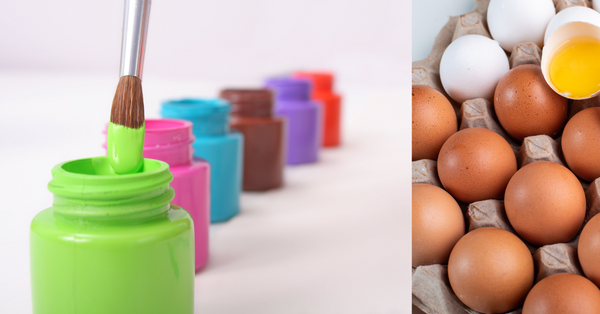
Craft vs Egg Tempera
Craft tempera was designed to be safe for kids and easy to wash off, so it isn’t very durable and doesn’t hold shape very well. On the other hand, egg tempera is more durable and easier to build with, which makes it more popular among professional artists.
From an aesthetic sense, egg tempera is pretty creamy and leaves a soft glowing quality as it is slightly more transparent than oil. Plus, it provides a matte finish texture and mixes well. Tempera is easily washed off with water, making it easy to clean yet insufficient in terms of longevity for some projects. Tempera can be used on a variety of materials but works best on paper, cardstock, masonite board, and wood.

Tempera dries very quickly but often requires several layers of paint for full coverage. It has a short shelf life of two to five years, but is more affordable than most acrylic paints. Also, tempera paints won’t last very long as they are made with non-toxic pigments.
Tips for Working with Egg Tempera
Want to channel your inner child and try painting with egg tempera? Use these tips for best results:
- Paint Thin and Dry – Egg tempera dries quickly, so it’s important to work fast. By applying thin layers of tempera, the paint will dry even quicker and create a strong bond between the paint and the surface. Also, painting with a dry brush rather than a wet brush will reduce lifting, which is another common issue when painting with egg tempera.
- Use Traditional Gesso to Prime Your Surface – Unsurprisingly, egg is not a strong or flexible binder. Therefore, you can apply traditional gesso (composed of gypsum, whiting, and rabbit skin glue) to the surface before applying egg tempera to create an absorbent ground for your paint to cling to.
- Use Brushes with Soft Hairs – Since egg tempera is a water-soluble paint, any of your watercolor or soft-hair brushes should do the trick. You’ll want the tip to be capable of holding a point or be shaped into a chisel.
What is Acrylic Paint?
Like tempera, acrylic paints are water-based. But, unlike temperas, acrylics will become water-resistant when dried. They are made from pigment suspended in acrylic polymer emulsion and plasticizers, silicone oils, defoamers, stabilizers, or metal soaps.
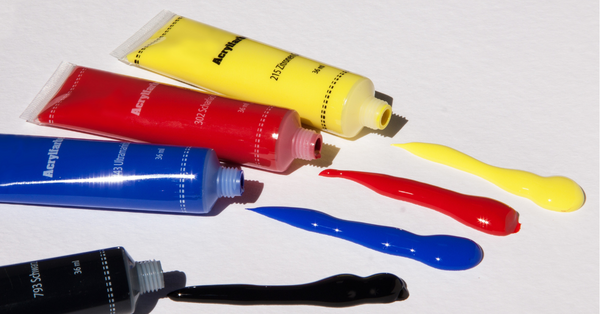
How is Acrylic Paint Different to Tempera Paint?
When compared to temperas, acrylic paints are thicker, more permanent, and have better opacity. Acrylics have become an extremely popular medium because of their fast-drying qualities, low toxicity, and ease of use. While beneficial from an efficiency standpoint, drying too quickly can be problematic for artists who are working to carefully add in subtle details as their piece progresses.
Acrylic paints are suitable for a wide range of surfaces including canvas, paper, wood, glass, and ceramic. They’re great for almost every type of painting or crafting project, and they mix well. Be aware, though, that some colors will dry slightly darker than they first appeared on the canvas. Furthermore, acrylics dry glossy to semi-glossy rather than matte like tempera paints.

Acrylics are slightly more expensive than temperas and can be more challenging to clean up, especially if clean up is delayed. Be sure to clean your paint brushes as soon as possible after using acrylic paints and avoid making a mess because once acrylic dries, it cannot be removed or altered.
Ultimately, acrylic paints offer more versatility and coverage than temperas. They can be used for a wide range of projects and are easy to incorporate into your portfolio of mediums.
TIP! If you’re looking for a good set of acrylic paints that won’t break the bank, I recommend the Arteza Acrylic Paint set which comes with 24 different colors at 22 ml. I always recommend getting an extra white paint (a large one like this one from Arteza) as this color always runs out first!
Tips for Working with Acrylic Paint
Interested in taking a stab at painting with acrylics? Follow these tips for best results:
- Prime Your Surface – While acrylics tend to be created with better binding agents than tempera paints, it is still important to prime your surface before beginning a project. This will ensure your painting lasts as long as possible and only takes a few extra steps.
- Clean Your Brushes After Each Use – Acrylic paint is very easy to clean off of your brushes; however, if you allow it to dry and harden, it becomes nearly impossible to remove completely. Unlike tempera, acrylics are water-resistant when dried. So, get in the habit of cleaning your brushes immediately after each use. It will save you time and money in the long run.
- Use Synthetic Paint Brushes – Synthetic brushes are best for acrylic paint because they’re durable and resistant enough to withstand the chemicals in acrylic paint. Plus, they aren’t too stiff or too soft, making them ideal for painting with acrylics.
Frequently Asked Questions
Can you mix acrylic and tempera paint?
Generally speaking, you shouldn’t really mix acrylic and tempera paints. While both are water-based, acrylics dry with a glossy finish and temperas dry with a matte finish, which won’t mix well.
Can you paint acrylic over tempera paint?
Since acrylic is thicker than tempera, it wouldn’t be wise to paint acrylic over tempera. The tempera paint already has a difficult time adhering, so adding extra weight on top of it would result in a lack of adhesion, flaking, and delamination.
Tempera vs. Acrylic Paint – Which is the Better Option for You?
Overall, acrylics are more versatile and easier to incorporate into your portfolio of mediums. However, tempera, and specifically egg tempera, can be used to create a beautiful translucent texture and matte finish that cannot be accomplished by working solely with acrylics. So, you should give both options a fair chance before ruling either of them out.
